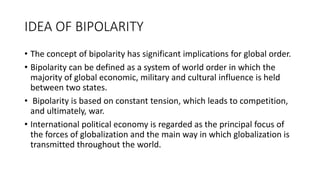After WWII, tensions rose between the two emerging superpowers, the United States and Soviet Union, leading to the establishment of a bipolar world order. The Soviets expanded their influence over Eastern Europe while the US asserted itself as a dominant military and economic power in the West. This division hardened at conferences like Yalta and Potsdam as mutual distrust grew. The US implemented the Truman Doctrine and Marshall Plan to contain communism and rebuild the Western allies, while the USSR established control over its satellite states in the Eastern bloc. The world was now split into two ideologically opposed camps in the early stages of the Cold War.







